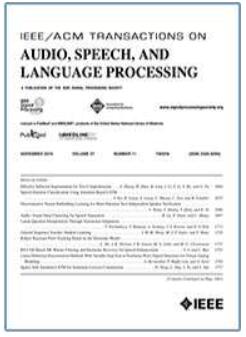BirdVoxDetect:用于鸟类迁徙监测的大规模飞行鸣叫检测和分类
IF 5.1
2区 计算机科学
Q1 ACOUSTICS
IEEE/ACM Transactions on Audio, Speech, and Language Processing
Pub Date : 2024-08-15
DOI:10.1109/TASLP.2024.3444486
引用次数: 0
摘要
声音事件分类有可能促进我们对鸟类迁徙的了解。虽然人们早就知道迁徙物种有自己的声音特征,但以前的自动飞行鸣叫分类工作在稳健性和范围上都很有限:例如,覆盖的记录点少、采集片段短、生物分类法简化。在本文中,我们介绍了 BirdVoxDetect(BVD),这是首个利用声学传感器网络数据监测鸟类迁徙的成熟解决方案。作为一款开源软件,BVD 集成了由三个机器学习模块组成的原创管道。第一个模块是传感器故障的随机森林分类器,由人工在环主动学习训练而成。第二个模块是用于声音事件检测的深度卷积神经网络,采用每通道能量归一化(PCEN)技术。第三个模块是一个多任务卷积神经网络,用于预测北美雀形目(Passeriformes)飞行鸣叫的科、属和种。我们在一个新的数据集上对 BVD 进行了评估(来自 9 个地点的 296 个小时,是迄今为止该任务中最大的数据集),并讨论了实际部署中估计误差的主要来源:机械传感器故障、对背景噪声的敏感性、错误检测和分类混淆。然后,我们以前所未有的规模部署了 BVD:6672 小时的音频(约 1 TB),相当于一整个鸟类迁徙季节。在整个季节的数据集上并行运行 BVD 可产生 16 亿次 FFT、4.8 亿次神经网络预测和超过 6 PB 的吞吐量。通过这种方法,我们的主要发现是,深度学习和生物声学传感器网络可以补充雷达观测和众包调查对鸟类迁徙的监测,从而有利于保护生态学和土地利用规划。本文章由计算机程序翻译,如有差异,请以英文原文为准。
BirdVoxDetect: Large-Scale Detection and Classification of Flight Calls for Bird Migration Monitoring
Sound event classification has the potential to advance our understanding of bird migration. Although it is long known that migratory species have a vocal signature of their own, previous work on automatic flight call classification has been limited in robustness and scope: e.g., covering few recording sites, short acquisition segments, and simplified biological taxonomies. In this paper, we present BirdVoxDetect (BVD), the first full-fledged solution to bird migration monitoring from acoustic sensor network data. As an open-source software, BVD integrates an original pipeline of three machine learning modules. The first module is a random forest classifier of sensor faults, trained with human-in-the-loop active learning. The second module is a deep convolutional neural network for sound event detection with per-channel energy normalization (PCEN). The third module is a multitask convolutional neural network which predicts the family, genus, and species of flight calls from passerines
(Passeriformes)
of North America. We evaluate BVD on a new dataset (296 hours from nine locations, the largest to date for this task) and discuss the main sources of estimation error in a real-world deployment: mechanical sensor failures, sensitivity to background noise, misdetection, and taxonomic confusion. Then, we deploy BVD to an unprecedented scale: 6672 hours of audio (approximately one terabyte), corresponding to a full season of bird migration. Running BVD in parallel over the full-season dataset yields 1.6 billion FFT's, 480 million neural network predictions, and over six petabytes of throughput. With this method, our main finding is that deep learning and bioacoustic sensor networks are ready to complement radar observations and crowdsourced surveys for bird migration monitoring, thus benefiting conservation ecology and land-use planning at large.
求助全文
通过发布文献求助,成功后即可免费获取论文全文。
去求助
来源期刊

IEEE/ACM Transactions on Audio, Speech, and Language Processing
ACOUSTICS-ENGINEERING, ELECTRICAL & ELECTRONIC
CiteScore
11.30
自引率
11.10%
发文量
217
期刊介绍:
The IEEE/ACM Transactions on Audio, Speech, and Language Processing covers audio, speech and language processing and the sciences that support them. In audio processing: transducers, room acoustics, active sound control, human audition, analysis/synthesis/coding of music, and consumer audio. In speech processing: areas such as speech analysis, synthesis, coding, speech and speaker recognition, speech production and perception, and speech enhancement. In language processing: speech and text analysis, understanding, generation, dialog management, translation, summarization, question answering and document indexing and retrieval, as well as general language modeling.
 求助内容:
求助内容: 应助结果提醒方式:
应助结果提醒方式:


